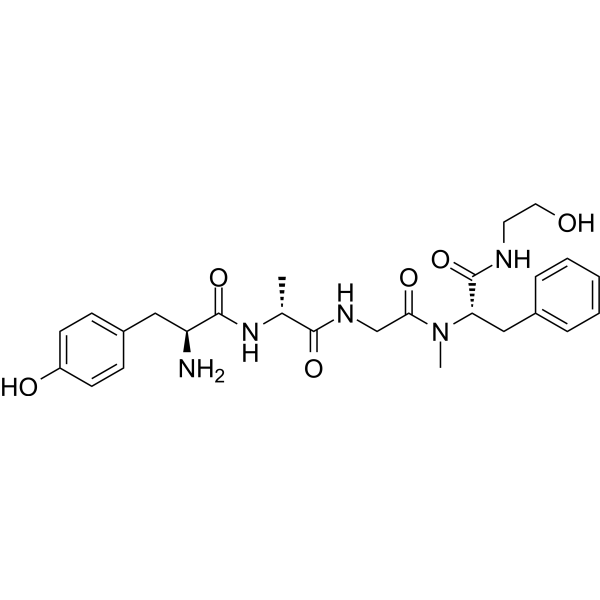| Description: |
DAMGO is a μ-opioid receptor (μ-OPR ) selective agonist. |
| Target: |
Kd: 3.46±0.84 nM (native μ-OPR)[1] |
| In Vitro: |
DAMGO, a μ-opioid receptor selective agonist, distinguishes between μ- and δ-opioid receptors around their first extracellular loops. In native μ-OPR, the Kd value for DAMGO is 3.46± 0.84 nM (n=3). The chimeric receptor MMDD, in which the carboxy-terminal half of μ-OPR is replaced with the corresponding region of δ-OPR, exhibits an equivalent affinity (Kd=2.13±0.40 nM; n=3) to DAMGO compared with the native μ-OPR[1]. DAMGO is a selective μ-opioid peptide. DAMGO abolishes the neuroprotective effect of CXCL12 in N-methyl-d-aspartate (NMDA) neurotoxicity studies. Regulation of neuronal response to CXCL12 is essential for shaping of developing and mature central nervous system (CNS). To establish whether DAMGO alter the effect of CXCL12 on neuronal survival, the ability of CXCL12 to protect neurons from N-methyl-d-aspartate (NMDA)-induced death is examined in the presence and absence of DAMGO. Cortical cultures are treated with DAMGO (1 and 10 μM). Neurons are subsequently exposed to NMDA (20 min) and/or CXCL12 (added 10 min before NMDA) in the absence of glia and then returned to the original culture dishes with the glial feeder layer. Neuronal death is evaluated after 24 h. DAMGO inhibits neuronal survival promoted by CXCL12[2]. |
| Cell Assay: |
Neurons (9 days in vitro) are treated with DAMGO (10 μM) for 24 h in their original culture dish, subsequently transferred to a dish containing Mg2+-free saline with glycine (15 μM), and exposed to NMDA (100 μM) and/or CXCL12 (20 nM) in absence of glia. After treatments, neurons are moved back into the original culture dishes containing glia. Neuronal death is evaluated after 24 h. Hoechst 33342 (3 μg/mL) combined with cleaved caspase-3 (1:100) staining is used to identify normal and apoptotic cells[2]. |
| References: |
[1]. FEBS Lett. 1995 Jan 2;357(1):93-7. Onogi T, et al. DAMGO, a mu-opioid receptor selective agonist, distinguishes between mu- and delta-opioid receptors around their first extracellular loops.
[2]. Patel JP, et al. Modulation of neuronal CXCR4 by the micro-opioid agonist DAMGO. J Neurovirol. 2006 Dec;12(6):492-500. |






















